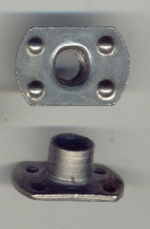
Stud welding
Encyclopedia

Spot welding
Spot welding is a process in which contacting metal surfaces are joined by the heat obtained from resistance to electric current flow. Work-pieces are held together under pressure exerted by electrodes. Typically the sheets are in the thickness range...
where a bolt
Bolt
-Fasteners:*A cap screw, as used in a bolted joint*Screw, a cylindrical threaded fastener*Dead bolt, a kind of locking mechanism*Bolt , an anchor point used in rock climbing-Weaponry:*Bolt , a mechanism used in firearms...
or specially formed nut
Nut (hardware)
A nut is a type of hardware fastener with a threaded hole. Nuts are almost always used opposite a mating bolt to fasten a stack of parts together. The two partners are kept together by a combination of their threads' friction, a slight stretch of the bolt, and compression of the parts...
is welded onto another metal part. The bolts may be automatically fed into the spot welder. Weld nuts generally have a flange with small nubs that melt to form the weld. Studs have a necked down, un-threaded area for the same purpose. Weld studs are used in stud welding systems.
Capacitor discharge weld studs range from 14 gauge to 3/8" diameter. They can come in many different lengths ranging from 1/4" to 5" and larger. The tip on the weld end of the stud serves a twofold purpose:
- It acts as a timing device to keep the stud off the base material
- It disintegrates when the trigger is pulled on the gun.
When the tip disintegrates, it melts and helps solidify the weld to the base material.
Arc studs range from a #8 to 1" diameter. The lengths are variable from 3/8" to 60" (for deformed bars). Arc studs are typically loaded with an aluminum flux ball on the weld end which aids in the welding process.
Stud welding, also known as stud arc welding, joins a stud and another piece of metal together. The stud is usually joined to a flat plate by using the stud as one of the electrodes. The polarity
Electrical polarity
Electrical polarity is present in every electrical circuit. Electrons flow from the negative pole to the positive pole. In a direct current circuit, one pole is always negative, the other pole is always positive and the electrons flow in one direction only...
used in stud welding depends on the type of metal being used. Welding aluminum, for example, would usually require direct-current electrode positive (DCEP). Welding steel would require direct-current electrode negative (DCEN).
Stud welding uses a type of flux called a ferrule, a ceramic ring which concentrates the heat generated, prevents oxidation and retains the molten metal in the weld zone. The ferrule is broken off of the fastener after the weld is completed.
Portable stud welding machines are available. Welders can also be automated, with controls for arcing and applying pressure. Stud welding is very versatile. Typical applications include automobile bodies, electrical panels, shipbuilding and building construction. Shipbuilding is one of the oldest uses of stud welding. Stud welding revolutionized the shipbuilding industry. All other manufacturing industries can also use stud welding for a variety of purposes.
A type of stud welding called capacitor-discharge (CD) stud welding differs from regular stud welding in that capacitor-discharge welding does not require flux. The weld time is shorter, enabling the weld to bond with little oxidation and no need for heat concentration. This process uses a direct-current arc from a capacitor. The weld time in this process is between 1 and 6 milliseconds. Capacitor discharge stud welding with the latest equipment can create a weld without burn through showing on the opposite side of very thin metals. CD stud welding is often used for smaller diameter studs and pins, as well as on non-standard materials and for accuracy. On the other hand, arc stud welding is primarily for structural purposes and larger diameter weld studs.

